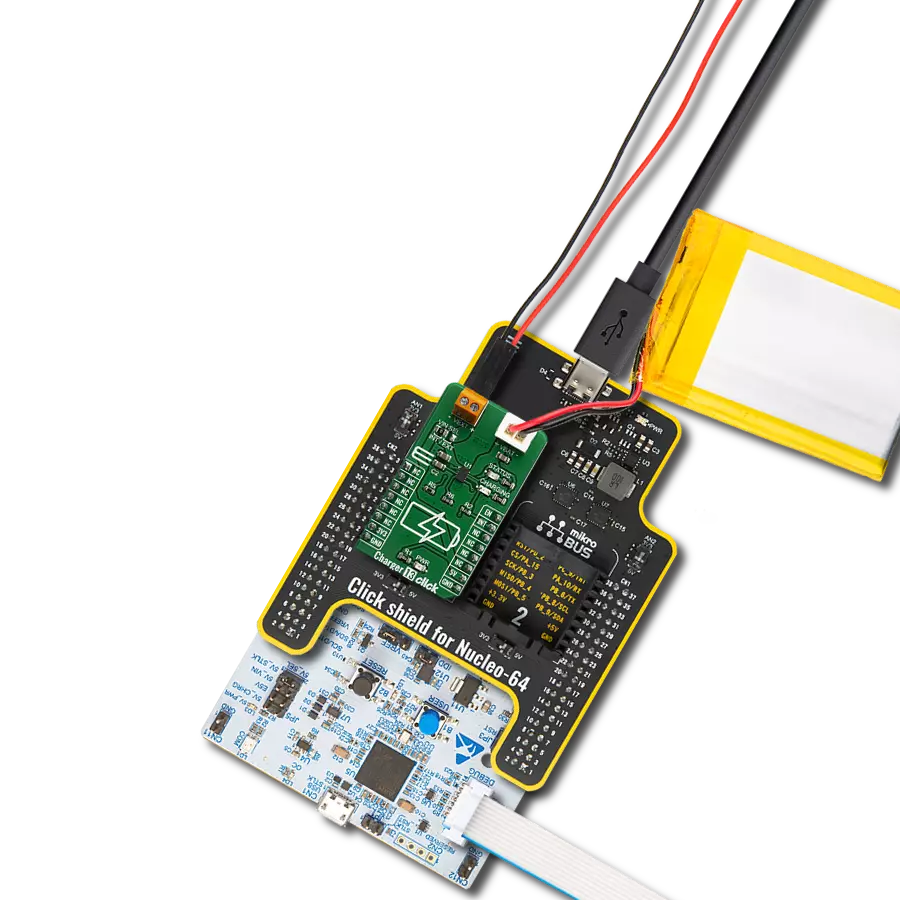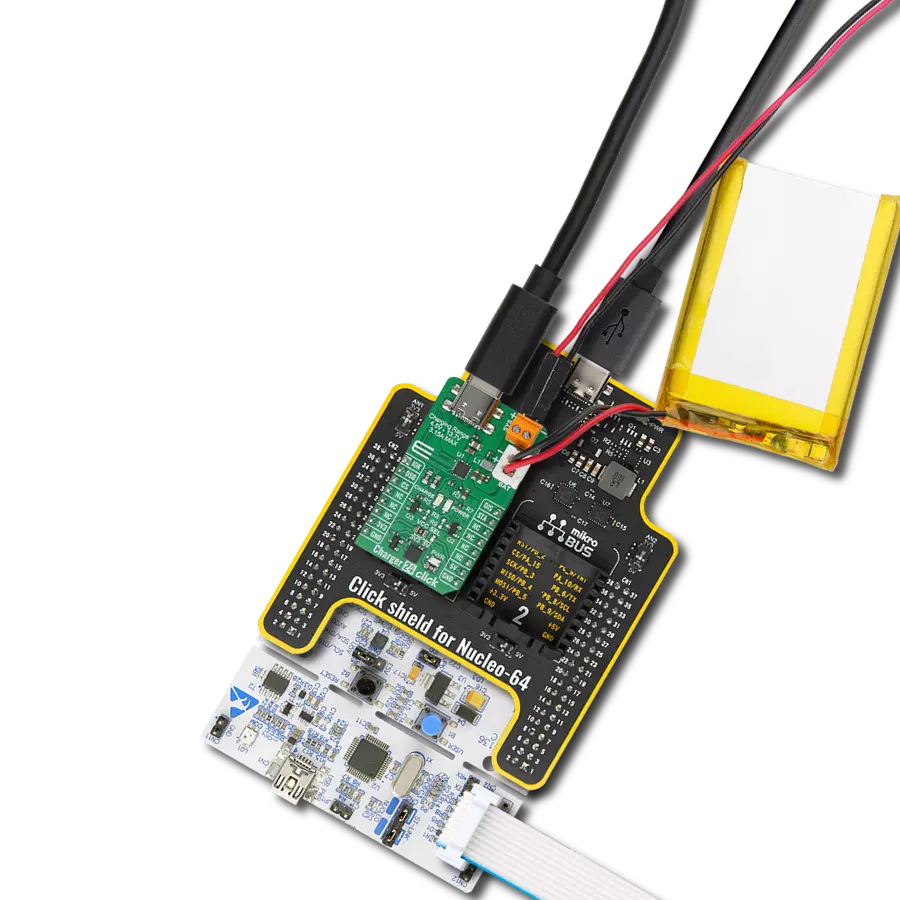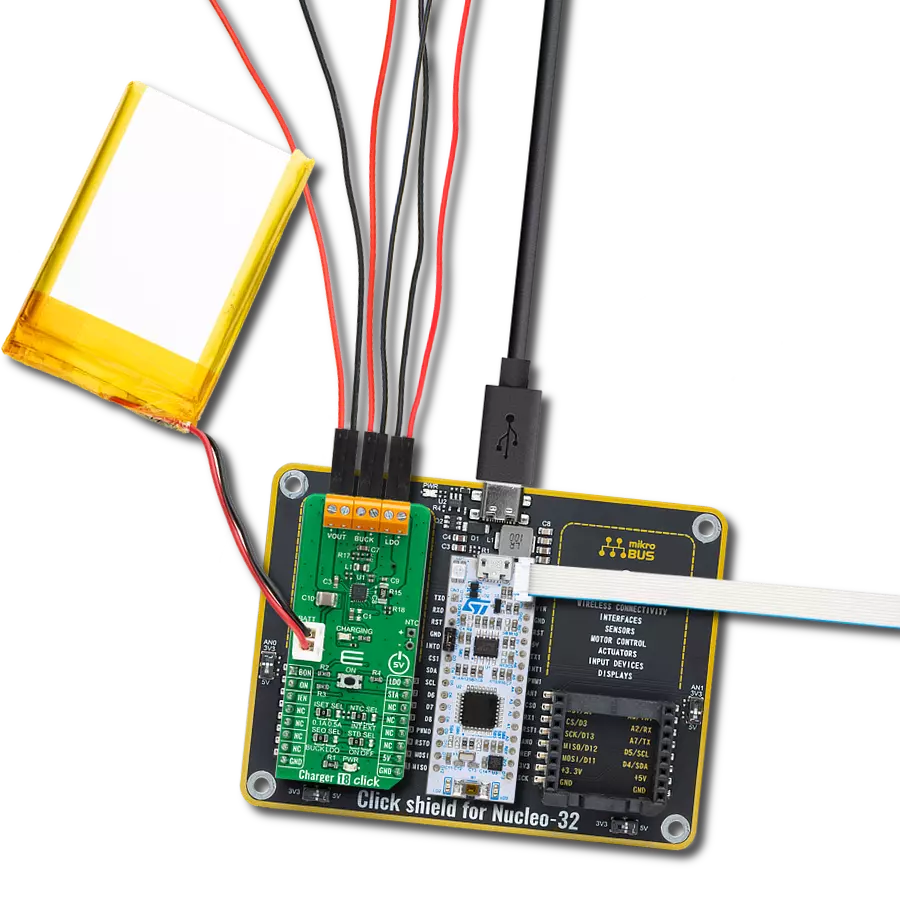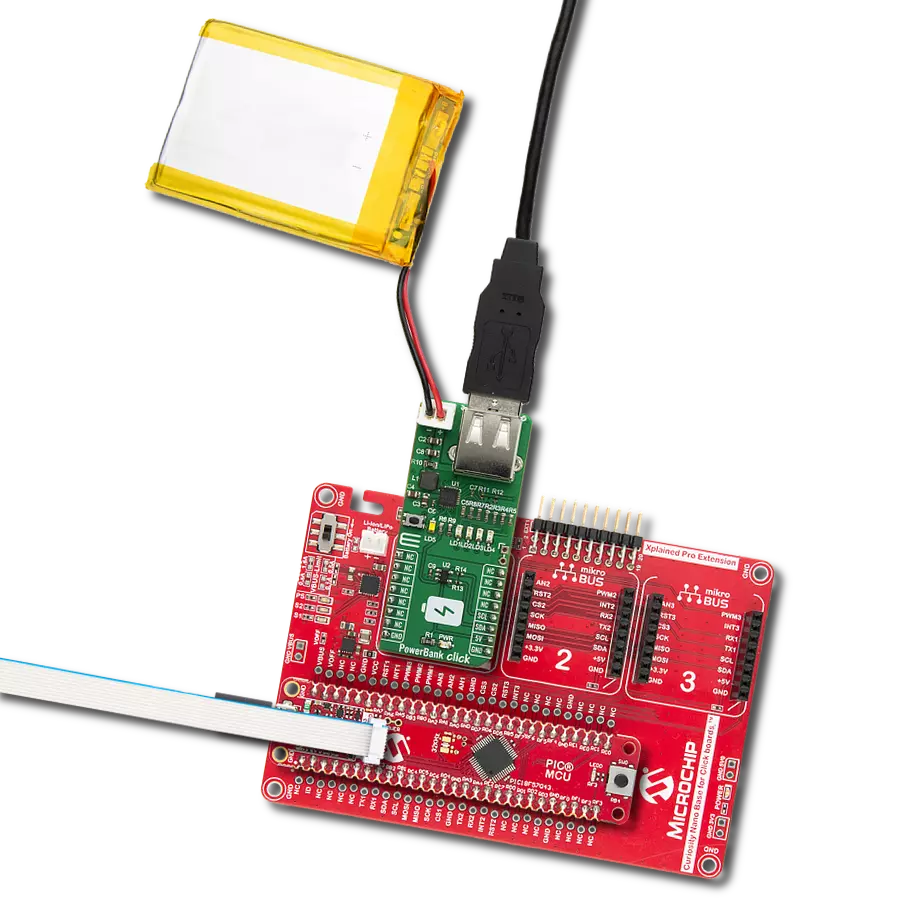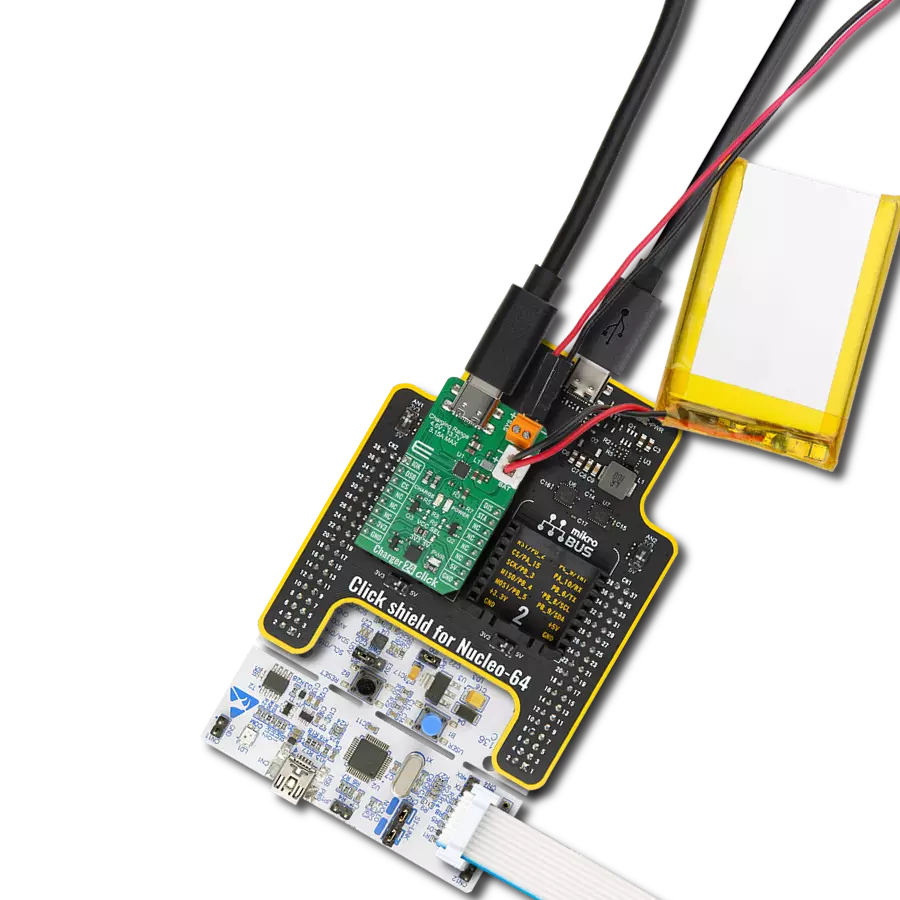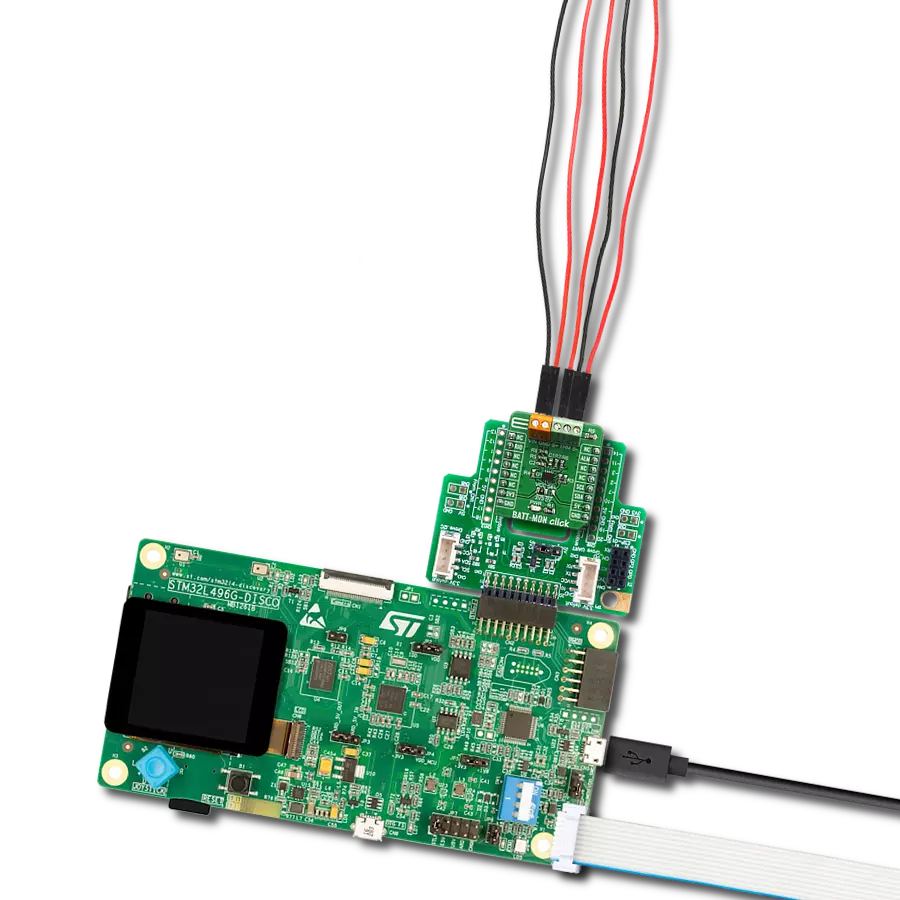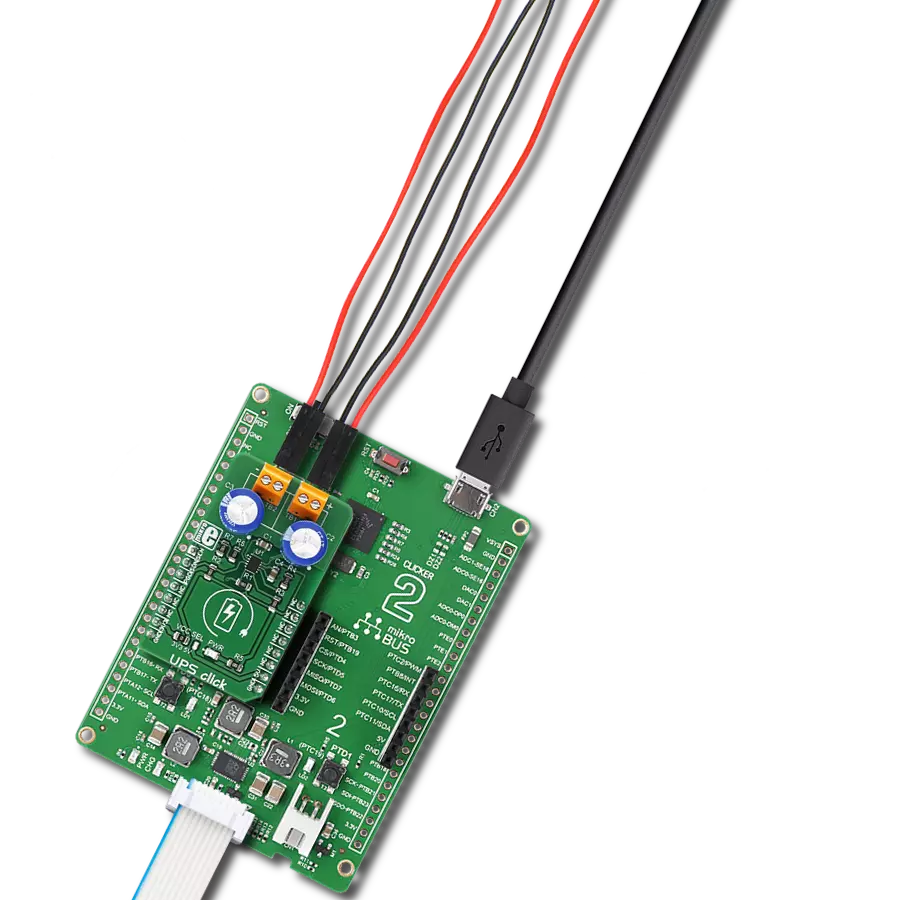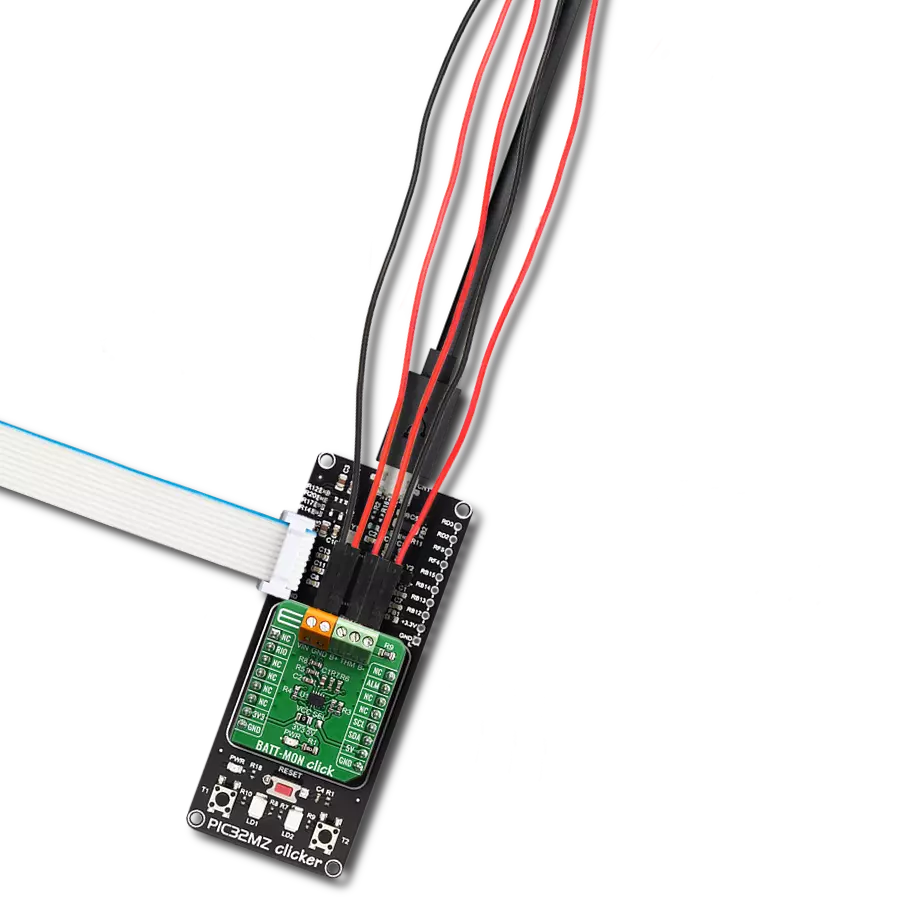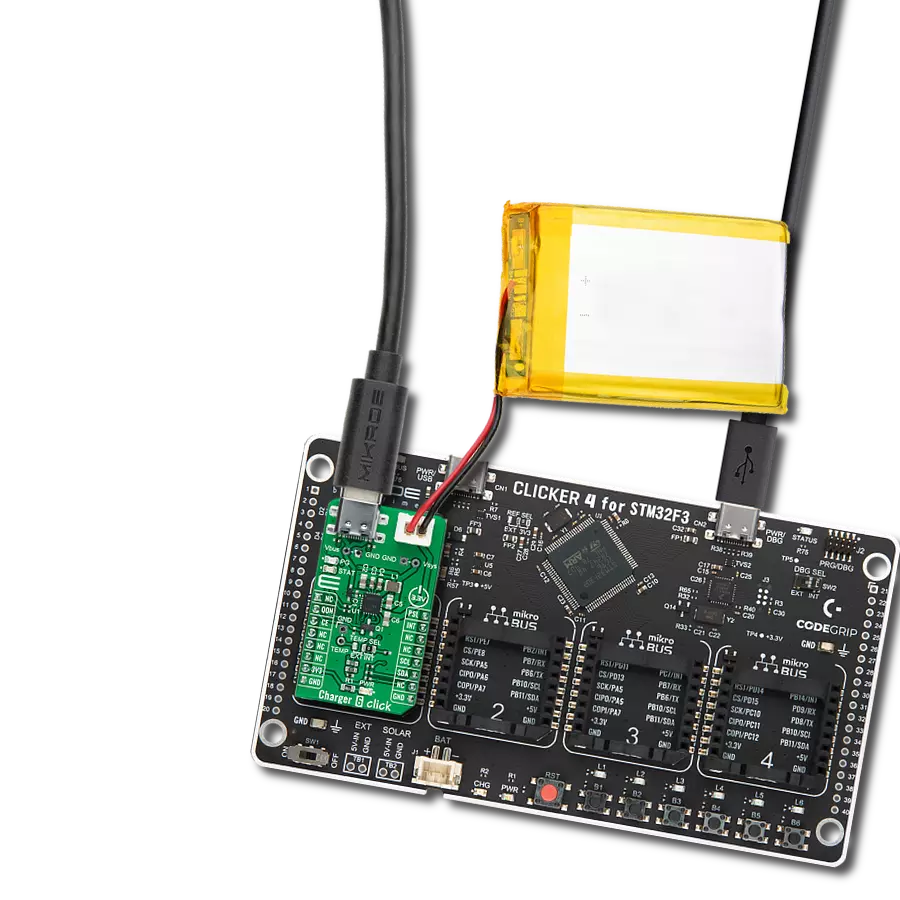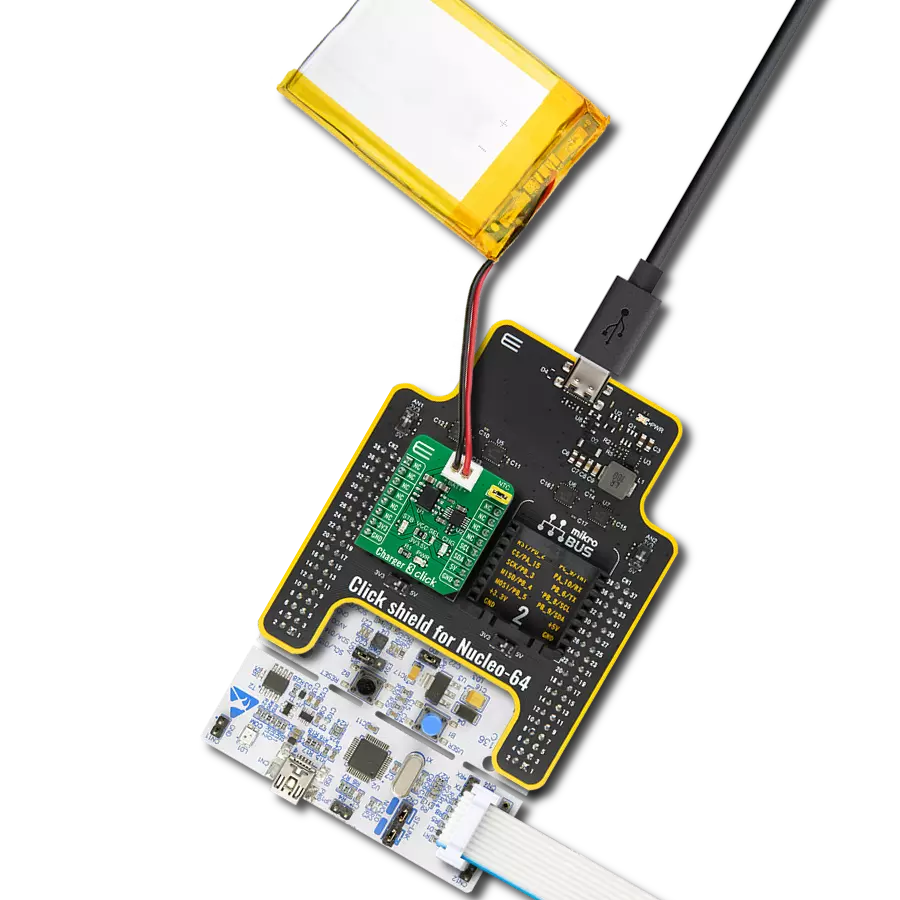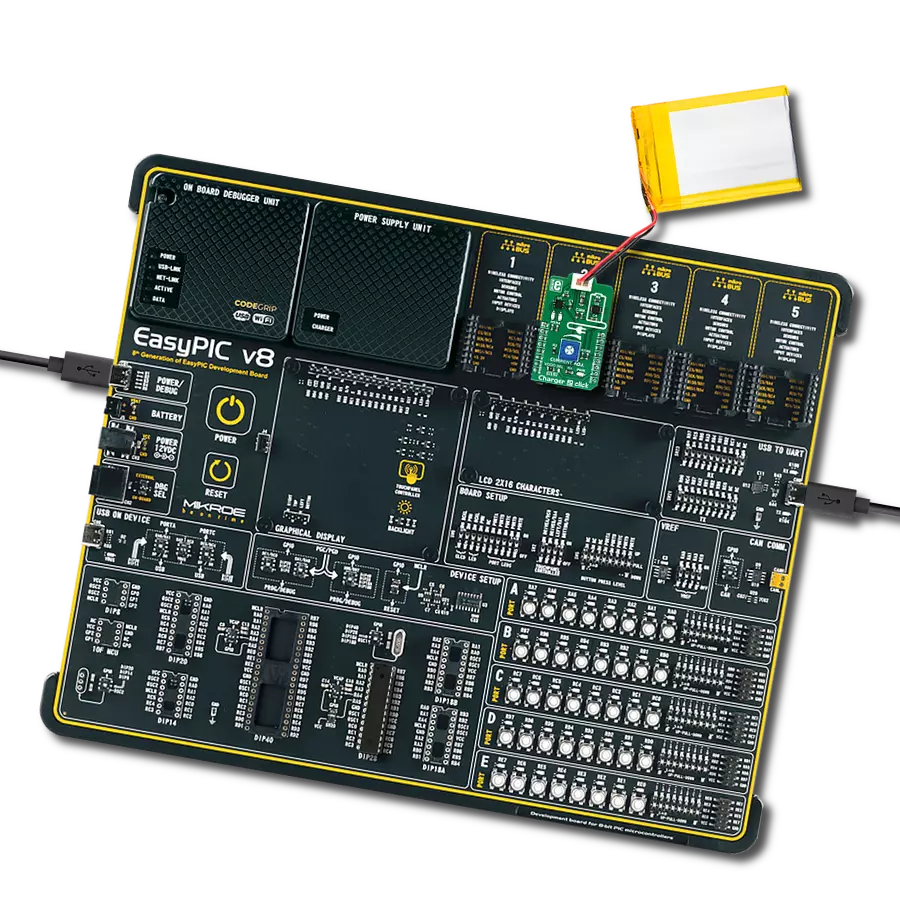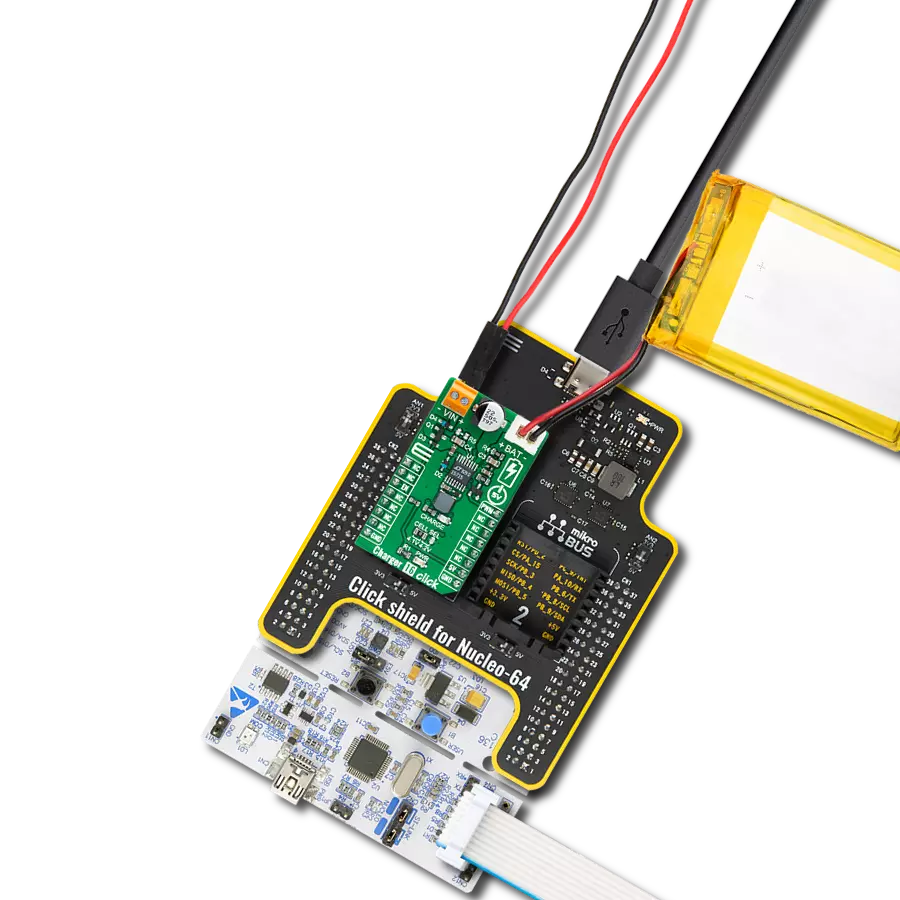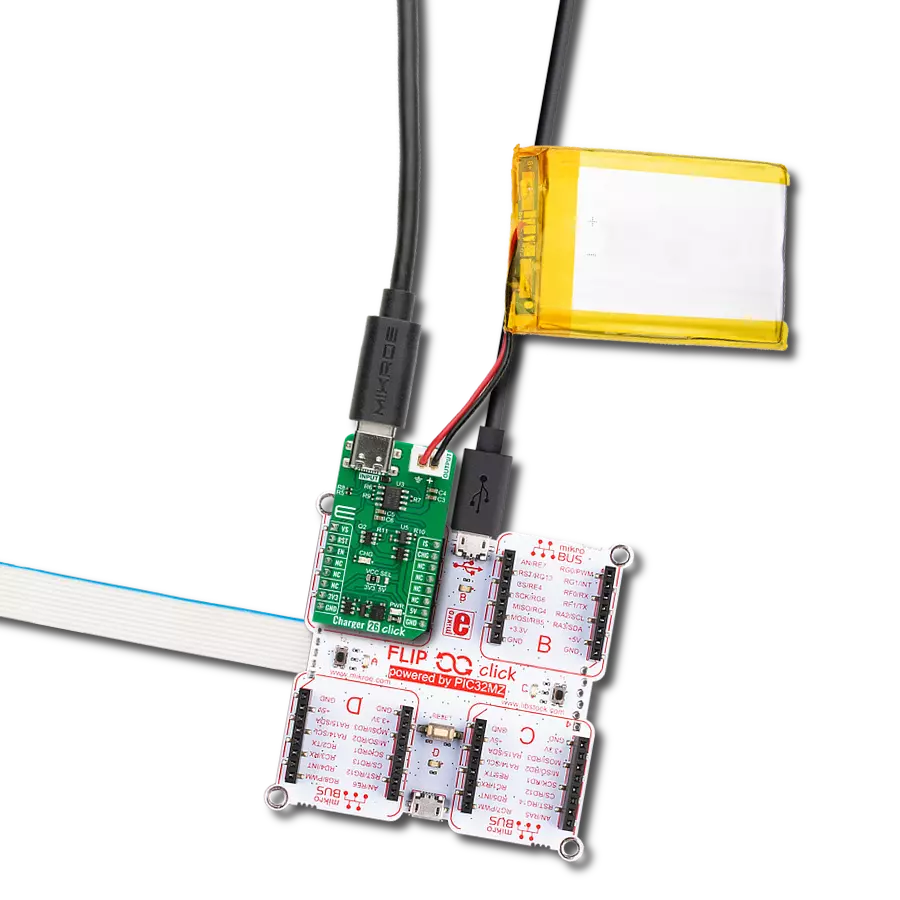The ultimate compact solution for seamless Li-Ion and Li-Polymer battery charging and monitoring, designed to keep your devices powered safely and efficiently
A
A
Hardware Overview
How does it work?
Charger Click is based on the MCP73831, a miniature single-cell, fully integrated Li-Ion, Li-Polymer charge management controller from Microchip. The MCP73831 is a highly advanced linear charge management controller that employs a constant-current/constant-voltage charge algorithm with selectable preconditioning and charge termination. The constant voltage is fixed to 4.20V, while the constant current value is set with an external R5 resistor to 250mA with a 3K9 resistor. The MCP73831 limits the charge current based on die temperature during high power or high ambient conditions, where this thermal regulation optimizes the charge cycle time while maintaining device reliability. The MCP73831
charges the battery cell over a battery connector, with a STAT LED indicator for visual presentation of charging status. Please remember that battery connectors are not standardized, and the wrong polarity connection can damage the battery, this Click board™, host MCU, or all mentioned. As a smart battery monitor, this Click board™ features the DS2438 from Analog Devices. It comes with 40 bytes of EEPROM that is available for storing important parameters about the battery, such as chemistry, capacity, and such. It eliminates the need for thermistors by sensing battery temperature on-chip. An onboard ADC converter allows battery voltage monitoring for end-of-charge and end-of-discharge determination, while an
onboard integrated current accumulator facilitates fuel gauging with an elapsed time meter in binary format. The Charger Click communicates with the host MCU over the 1-Wire interface with either OW2 or OW1 pins selected via OW SEL jumper with OW1 set by default. As each DS2438 has its unique ID, several units of these Charger Clicks can work on the same 1-Wire bus. This Click board™ can only be operated with a 5V logic voltage level. The board must perform appropriate logic voltage level conversion before using MCUs with different logic levels. However, the Click board™ comes equipped with a library containing functions and an example code that can be used as a reference for further development.
Features overview
Development board
Nucleo-64 with STM32G474R MCU offers a cost-effective and adaptable platform for developers to explore new ideas and prototype their designs. This board harnesses the versatility of the STM32 microcontroller, enabling users to select the optimal balance of performance and power consumption for their projects. It accommodates the STM32 microcontroller in the LQFP64 package and includes essential components such as a user LED, which doubles as an ARDUINO® signal, alongside user and reset push-buttons, and a 32.768kHz crystal oscillator for precise timing operations. Designed with expansion and flexibility in mind, the Nucleo-64 board features an ARDUINO® Uno V3 expansion connector and ST morpho extension pin
headers, granting complete access to the STM32's I/Os for comprehensive project integration. Power supply options are adaptable, supporting ST-LINK USB VBUS or external power sources, ensuring adaptability in various development environments. The board also has an on-board ST-LINK debugger/programmer with USB re-enumeration capability, simplifying the programming and debugging process. Moreover, the board is designed to simplify advanced development with its external SMPS for efficient Vcore logic supply, support for USB Device full speed or USB SNK/UFP full speed, and built-in cryptographic features, enhancing both the power efficiency and security of projects. Additional connectivity is
provided through dedicated connectors for external SMPS experimentation, a USB connector for the ST-LINK, and a MIPI® debug connector, expanding the possibilities for hardware interfacing and experimentation. Developers will find extensive support through comprehensive free software libraries and examples, courtesy of the STM32Cube MCU Package. This, combined with compatibility with a wide array of Integrated Development Environments (IDEs), including IAR Embedded Workbench®, MDK-ARM, and STM32CubeIDE, ensures a smooth and efficient development experience, allowing users to fully leverage the capabilities of the Nucleo-64 board in their projects.
Microcontroller Overview
MCU Card / MCU
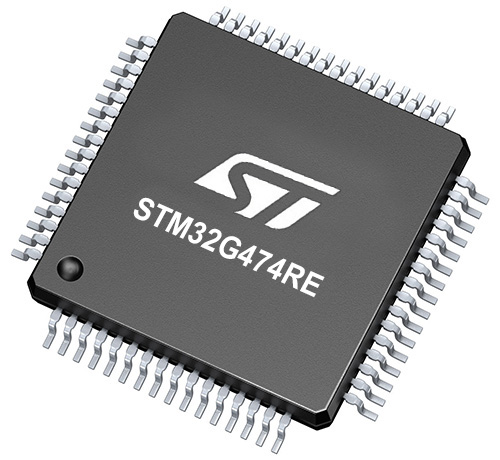
Architecture
ARM Cortex-M4
MCU Memory (KB)
512
Silicon Vendor
STMicroelectronics
Pin count
64
RAM (Bytes)
128k
You complete me!
Accessories
Click Shield for Nucleo-64 comes equipped with two proprietary mikroBUS™ sockets, allowing all the Click board™ devices to be interfaced with the STM32 Nucleo-64 board with no effort. This way, Mikroe allows its users to add any functionality from our ever-growing range of Click boards™, such as WiFi, GSM, GPS, Bluetooth, ZigBee, environmental sensors, LEDs, speech recognition, motor control, movement sensors, and many more. More than 1537 Click boards™, which can be stacked and integrated, are at your disposal. The STM32 Nucleo-64 boards are based on the microcontrollers in 64-pin packages, a 32-bit MCU with an ARM Cortex M4 processor operating at 84MHz, 512Kb Flash, and 96KB SRAM, divided into two regions where the top section represents the ST-Link/V2 debugger and programmer while the bottom section of the board is an actual development board. These boards are controlled and powered conveniently through a USB connection to program and efficiently debug the Nucleo-64 board out of the box, with an additional USB cable connected to the USB mini port on the board. Most of the STM32 microcontroller pins are brought to the IO pins on the left and right edge of the board, which are then connected to two existing mikroBUS™ sockets. This Click Shield also has several switches that perform functions such as selecting the logic levels of analog signals on mikroBUS™ sockets and selecting logic voltage levels of the mikroBUS™ sockets themselves. Besides, the user is offered the possibility of using any Click board™ with the help of existing bidirectional level-shifting voltage translators, regardless of whether the Click board™ operates at a 3.3V or 5V logic voltage level. Once you connect the STM32 Nucleo-64 board with our Click Shield for Nucleo-64, you can access hundreds of Click boards™, working with 3.3V or 5V logic voltage levels.
Li-Polymer Battery is the ideal solution for devices that demand a dependable and long-lasting power supply while emphasizing mobility. Its compatibility with mikromedia boards ensures easy integration without additional modifications. With a voltage output of 3.7V, the battery meets the standard requirements of many electronic devices. Additionally, boasting a capacity of 2000mAh, it can store a substantial amount of energy, providing sustained power for extended periods. This feature minimizes the need for frequent recharging or replacement. Overall, the Li-Polymer Battery is a reliable and autonomous power source, ideally suited for devices requiring a stable and enduring energy solution. You can find a more extensive choice of Li-Polymer batteries in our offer.
Used MCU Pins
mikroBUS™ mapper
Take a closer look
Click board™ Schematic

Step by step
Project assembly
Software Support
Library Description
This library contains API for Charger Click driver.
Key functions:
charger_read_temperature- This function reads the chip internal temperature measurement in degrees Celsiuscharger_read_batt_vdd- This function reads the battery input voltagecharger_read_current- This function reads the battery charging current
Open Source
Code example
The complete application code and a ready-to-use project are available through the NECTO Studio Package Manager for direct installation in the NECTO Studio. The application code can also be found on the MIKROE GitHub account.
/*!
* @file main.c
* @brief Charger Click Example.
*
* # Description
* This example demonstrates the use of Charger Click board by monitoring
* the battery charging status.
*
* The demo application is composed of two sections :
*
* ## Application Init
* Initializes the driver, performs the Click default configuration, calibrates
* the zero current charging offset, and resets the elapsed time counter.
*
* ## Application Task
* Reads the chip internal temperature, battery and system VDD, battery charging
* current, and the elapsed time counter, approximately once per second. All data
* are displayed on the USB UART where you can track their changes.
*
* @author Stefan Filipovic
*
*/
#include "board.h"
#include "log.h"
#include "charger.h"
static charger_t charger;
static log_t logger;
void application_init ( void )
{
log_cfg_t log_cfg; /**< Logger config object. */
charger_cfg_t charger_cfg; /**< Click config object. */
/**
* Logger initialization.
* Default baud rate: 115200
* Default log level: LOG_LEVEL_DEBUG
* @note If USB_UART_RX and USB_UART_TX
* are defined as HAL_PIN_NC, you will
* need to define them manually for log to work.
* See @b LOG_MAP_USB_UART macro definition for detailed explanation.
*/
LOG_MAP_USB_UART( log_cfg );
log_init( &logger, &log_cfg );
log_info( &logger, " Application Init " );
// Click initialization.
charger_cfg_setup( &charger_cfg );
CHARGER_MAP_MIKROBUS( charger_cfg, MIKROBUS_1 );
if ( ONE_WIRE_ERROR == charger_init( &charger, &charger_cfg ) )
{
log_error( &logger, " Communication init." );
for ( ; ; );
}
if ( CHARGER_ERROR == charger_default_cfg ( &charger ) )
{
log_error( &logger, " Default configuration." );
for ( ; ; );
}
log_printf( &logger, "\r\n Zero current calibration process\r\n" );
log_printf( &logger, " Keep the battery disconnected in the next 5 seconds\r\n" );
Delay_ms ( 1000 );
Delay_ms ( 1000 );
Delay_ms ( 1000 );
if ( CHARGER_ERROR == charger_calibrate_current ( &charger ) )
{
log_error( &logger, " Calibration." );
for ( ; ; );
}
log_printf( &logger, " Calibration done!\r\n\n" );
if ( CHARGER_OK == charger_write_elapsed_time ( &charger, 0 ) )
{
log_printf( &logger, " Elapsed time reset done!\r\n\n" );
}
log_info( &logger, " Application Task " );
}
void application_task ( void )
{
float temperature = 0;
float batt_vdd = 0;
float system_vdd = 0;
float current = 0;
uint32_t elapsed_time = 0;
if ( CHARGER_OK == charger_read_temperature ( &charger, &temperature ) )
{
log_printf( &logger, " Temperature: %.2f degC\r\n", temperature );
}
if ( CHARGER_OK == charger_read_batt_vdd ( &charger, &batt_vdd ) )
{
log_printf( &logger, " Battery VDD: %.3f V\r\n", batt_vdd );
}
if ( CHARGER_OK == charger_read_system_vdd ( &charger, &system_vdd ) )
{
log_printf( &logger, " System VDD: %.3f V\r\n", system_vdd );
}
if ( CHARGER_OK == charger_read_current ( &charger, ¤t ) )
{
log_printf( &logger, " Charging current: %.3f A\r\n", current );
}
if ( CHARGER_OK == charger_read_elapsed_time ( &charger, &elapsed_time ) )
{
log_printf( &logger, " Elapsed time: %lu s\r\n\n", elapsed_time );
}
Delay_ms ( 1000 );
}
int main ( void )
{
/* Do not remove this line or clock might not be set correctly. */
#ifdef PREINIT_SUPPORTED
preinit();
#endif
application_init( );
for ( ; ; )
{
application_task( );
}
return 0;
}
// ------------------------------------------------------------------------ END
Additional Support
Resources
Category:Battery charger




















